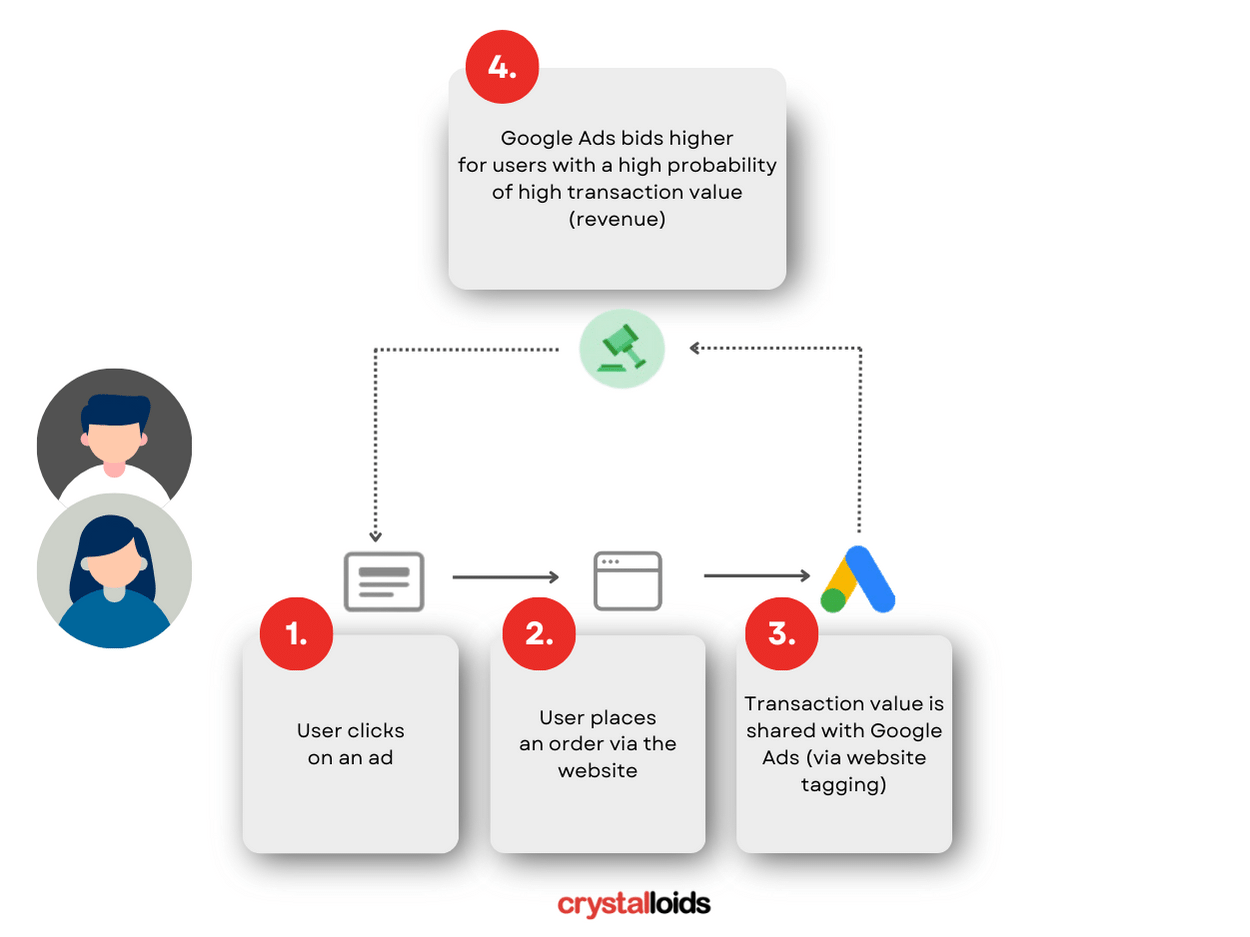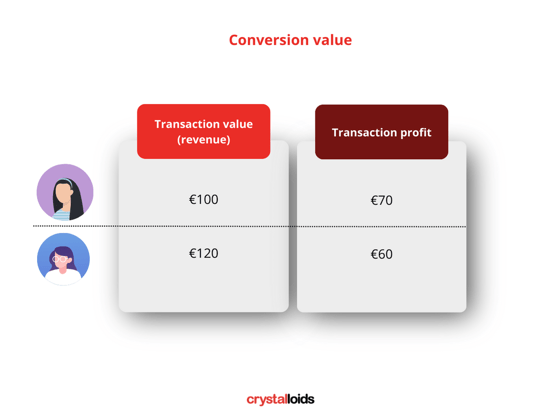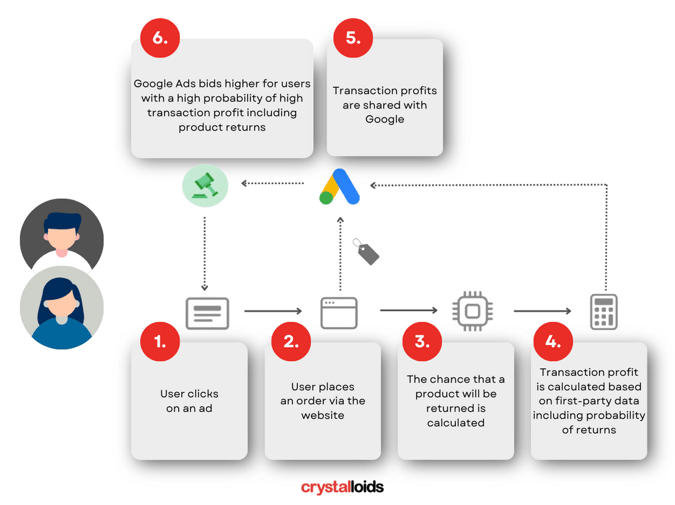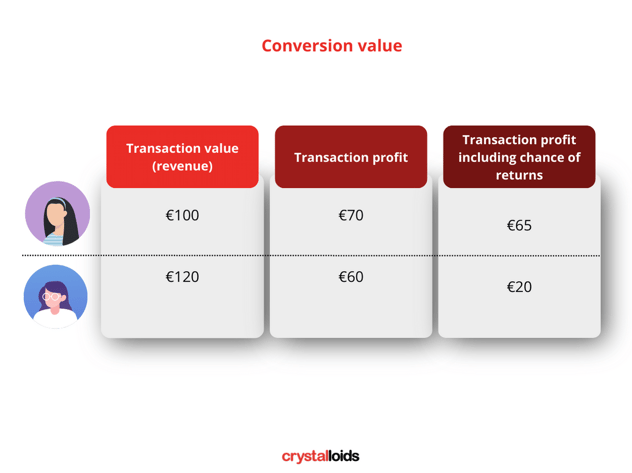Share this
Value Based Bidding: The Secret to Smarter, More Profitable Ads
by Crystalloids Team on Jan 29, 2024 10:53:49 AM

Reducing product returns can lead to bigger profits, and this is also true for Google Ads. By using Machine Learning to predict return rates and incorporating this into your Value-Based Bidding strategy, you can increase your profits.
For e-commerce, especially in the fashion industry, dealing with a lot of returns is a big problem. Usually, 10 to 35 percent of orders end up being returned. This has major consequences for returns and also places an additional burden on the environment. Every activity to reduce the number of returns is therefore important.
Bidding algorithms with rich first-party data – or Value-Based Bidding – has a proven positive effect on profits and returns. In this article I explain how you can use this. In this article I will explain you how to do this.
Value Based Bidding in Google Ads explained
Google Ads is essential for many companies. A large part of the marketing budget therefore goes to this platform. It is important that this budget is used as effectively as possible.
Value-Based Bidding, called Smart Bidding in Google Ads, is an automatic value bidding strategy that can be used to increase effectiveness and achieve greater returns. With this strategy, a conversion value for that transaction is shared with Google Ads immediately after a transaction.
This conversion value is used to maximize conversion value by optimizing the bidding strategy and the conversion rate. Many businesses use Value-Based Bidding in Google Ads as one of their best practices. and use the turnover of transactions to optimize their bidding. In this way they optimize the ROAS (Return on Ad Spend).

Optimizing Profit with Conversion Value
Higher turnover doesn't automatically lead to greater profit. It's crucial to focus on the customer lifetime value, especially when you use Google Ads. This approach prioritizes long-term profitability rather than short-term revenue.
This can be done by combining revenue per transaction with first-party data such as product margins and handling costs. By considering profit as a different value for the conversion action, the strategy is fine-tuned to maximize POAS (Profit on Ad Spend).

Consider an example of two customers, Irene and Tineke, who both make purchases via the website. Irene's order contributes to a larger turnover compared to Tineke. However, Tineke's order includes mostly products purchased by the webshop, while Irene's includes more of her own brand products. Consequently, Irene's order yields a higher margin (profit) than Tineke's.
Tineke's transaction therefore has a higher value with a lower margin. In the situation where revenue is used to optimize the automated bidding strategy, the CPC (Cost per Click) would be high with similar signals. By looking at the margin instead of turnover per transaction, the CPC is low. After all, a lower margin is less interesting.
Irene buys a number of products with a relatively lower sales value. However, the products she buys have a high margin, so the final margin left is higher than Irene's order. This signal is shared with Google Ads, which means that the Google Ads model focuses on high-profit orders. In the new situation, the CPC is high for comparable signals. This higher CPC more than pays for itself.
Predicting product returns
The profit that can be calculated immediately after a transaction is often not the final profit that remains. Customers can still return ordered products.
To make the conversion value more precise, it is valuable to include product returns. The problem, however, is that product returns are not immediately known after placing an order. Customers' return behavior will therefore have to be predicted at the time they place the order.
We use a prediction model based on machine learning to predict the return rate of products in a transaction. Important features that can be used by the model are, for example, the number of products in the transaction, the number of the same products in a transaction, customer return history, and also the payment method such as post-payment, are predictors of return behavior.

Let's illustrate this with the example of Irene and Tineke. Both place orders of equal estimated value. Irene selects a single product and opts for immediate payment via iDeal, while Tineke orders several variations of the same product and chooses Klarna for post-payment.
For this example, let's assume the margin is the same for both orders. In addition to margin, the chance of returns also has an impact on the expected profit. By predicting the likelihood of returns and including them in the conversion value, Google Ads will offer a high CPC for signals similar to Irene and a low CPC for signals similar to Tineke. This is because the chance that Tineke will return products is many times greater than the chance that Irene will do so and this has an impact on the final profit that remains.

Leveraging Value-Based Bidding for Success
Shifting from a turnover-driven to a profit-driven bidding strategy, and using value based bidding, results in a significant uplift in the final margin that is achieved. Based on my experience, I dare say that an uplift of 15% or even more is realistic. Although this will differ per market and even per brand.
Since the investment is relatively low and the higher advertising costs are more than offset by the higher margin, a positive business case is quickly made.
Moreover, this adjusted smart bidding strategy has a positive effect on the number of returns. Based on the example of Irene and Tineke, we see that bids are lower on orders that have a greater chance of returns. Here too I dare to say that a reduction in the number of returns by 5% is not unrealistic. This approach truly emphasizes the value of a conversion.
Maximizing Results through Technology Integration
Centralizing data for these use case(s) in Google Cloud Platform is central to the development. If you are not yet active on Google Cloud, we only use the data and Google Cloud technology necessary to realize this use case. No license is required and no technical management because this is done by Google. You can develop CDP functionalities incrementally without a license.
First-party data is essential for calculating margin per transaction and predicting return behavior. The correct collection and processing of first-party data is therefore a requirement. This requires specific data engineering and data science skills.
To further enhance the process, set up value-based bidding based on the value of each transaction and its value to your business.
Vertex AI, Google's AI platform, is used to predict and gain deeper insights from the data. Ultimately, the conversion values are shared with Google Ads via a direct interface. This also requires specific data engineering skills.
It is good to mention that we only use anonymous IDs and not e-mail addresses or other personally identifiable information. And we only work with data that has the correct legal basis.
Conclusion
To get more out of Google Ads, it's essential to utilize Value-Based Bidding centered around profit. Make sure to set up conversion tracking that includes return behavior in the profit calculation. This strategic approach aims to maximize conversion value by optimizing the uplift margin and minimizing the number of returns. The beauty of this strategy lies in its ability to deliver a positive business case effortlessly, thanks to its limited investment and positive impact on the margin.
If you lack the necessary skills and experience, consider partnering with Crystalloids. Our expertise can help you get started and quickly reap the benefits of these strategies.
Share this
- December 2025 (2)
- November 2025 (2)
- October 2025 (2)
- September 2025 (3)
- August 2025 (2)
- July 2025 (1)
- June 2025 (1)
- April 2025 (4)
- February 2025 (2)
- January 2025 (3)
- December 2024 (1)
- November 2024 (5)
- October 2024 (2)
- September 2024 (1)
- August 2024 (1)
- July 2024 (4)
- June 2024 (2)
- May 2024 (1)
- April 2024 (4)
- March 2024 (2)
- February 2024 (2)
- January 2024 (4)
- December 2023 (1)
- November 2023 (4)
- October 2023 (4)
- September 2023 (4)
- June 2023 (2)
- May 2023 (2)
- April 2023 (1)
- March 2023 (1)
- January 2023 (4)
- December 2022 (3)
- November 2022 (5)
- October 2022 (3)
- July 2022 (1)
- May 2022 (2)
- April 2022 (2)
- March 2022 (5)
- February 2022 (2)
- January 2022 (5)
- December 2021 (5)
- November 2021 (4)
- October 2021 (2)
- September 2021 (1)
- August 2021 (3)
- July 2021 (4)
- May 2021 (2)
- April 2021 (2)
- February 2021 (2)
- December 2020 (1)
- October 2020 (2)
- September 2020 (1)
- August 2020 (2)
- July 2020 (2)
- June 2020 (1)
- March 2020 (2)
- February 2020 (1)
- January 2020 (1)
- November 2019 (3)
- October 2019 (2)
- September 2019 (3)
- August 2019 (2)
- July 2019 (3)
- June 2019 (5)
- May 2019 (2)
- April 2019 (4)
- March 2019 (2)
- February 2019 (2)
- January 2019 (4)
- December 2018 (2)
- November 2018 (1)
- October 2018 (1)
- September 2018 (2)
- August 2018 (3)
- July 2018 (3)
- May 2018 (2)
- April 2018 (4)
- March 2018 (5)
- February 2018 (1)
- January 2018 (3)
- November 2017 (2)
- October 2017 (2)



